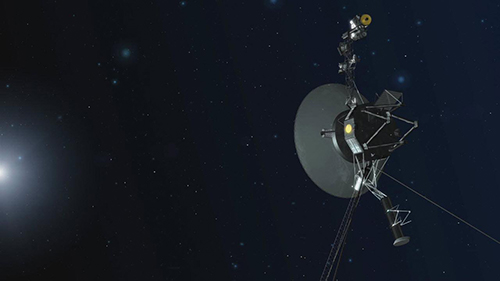In 2012, Voyager 1 became the first humanmade object to leave the solar system when the space probe traversed the heliopause—the boundary at which the outflow of plasma from the Sun, known as solar wind, gives way to the collective solar winds from other stars. Those solar winds partially comprise the interstellar medium, which is the matter and radiation that exists between stars. Voyager 1 has since made inferential measurements of the density of the interstellar medium when the Sun undergoes a sporadic outburst, known as a solar flare—an event that forms large waves in the ambient plasma outside the heliopause. Now, researchers have carefully analyzed the probe's readings to find a never-before-measured, persistent faint noise or “hum” in the data that appears to be directly due to small, constant waves in the interstellar medium. The findings demonstrate a way to continuously measure the interstellar medium without having to rely on solar flares. Mapping and characterizing this medium are important for learning more about how stars form and evolve, as well as the structure and dynamics of the heliosphere—the bubble that the Sun carves out from the interstellar medium. For the foreseeable future, only Voyager spacecrafts will have direct access to this farthest frontier, making every bit of science gathered potentially critical. See also: Density; Interstellar matter; Plasma (physics); Solar system; Solar wind; Space probe; Star; Stellar evolution; Sun; Voyager 1 crosses the heliopause into interstellar space; Voyager spacecraft and the edge of the heliosphere

An instrument known as the Plasma Wave Subsystem made the observations. The instrument is a radio frequency receiver that had originally measured the magnetospheres of gas giant planets Jupiter and Saturn in 1979 and 1980, respectively. This instrument gathers data through two V-shaped "bunny ear" antennas that project outward 10 meters (33 feet) from the spacecraft. The antennas can detect frequency vibrations from electrons caused by waves passing through the extremely sparse matter in space. The waves themselves come from multiple sources, including the rotation of the Milky Way galaxy, supernova explosions, and locally, the Sun's outbursts. The pitch of the sound of electron frequency vibrations reveals the overall plasma density in the interstellar medium, with higher pitches corresponding to higher density. See also: Antenna (electromagnetism); Electromagnetic wave; Electron; Jupiter; Magnetosphere; Milky Way Galaxy; Pitch; Radio receiver; Saturn; Supernova
Infrequent solar outbursts have enabled Voyager to gather point estimates of the interstellar medium since 2013, revealing a substantial density gradient and turbulence. Seeking a signal that could provide more comprehensive insight into the interstellar medium's density, researchers recently parsed the data collected by Plasma Wave Subsystem and newly identified a weak but consistent signal. The signal arises from plasma wave emissions that occur when the density of the plasma changes. Overall, the data gathered by Voyager 1 show that interstellar medium's density began increasing around 2013 and rose substantially by mid-2015, largely holding steady since then. The newfound signal's durability suggests that the Voyager probe will likely be able to keep collecting data on the interstellar medium for years to come, and without requiring outbursts from the Sun—possibly even until the probe's science instruments and transmitter break down, which is expected to occur in the 2020s or early 2030s. See also: Instrument science; Turbulent flow





